Economics
To explain the main events of economic history and the economic thinking about them from the beginning of the twentieth century to the present.
32 Pages10865 Words98 Views
Added on 2023-01-23
About This Document
Desklib is an online library that provides study material for Economics, including solved assignments, essays, and dissertations. Find high-quality content for your Economics courses and enhance your learning experience.
Economics
To explain the main events of economic history and the economic thinking about them from the beginning of the twentieth century to the present.
Added on 2023-01-23
ShareRelated Documents
Running head: ECONOMICS
Economics
Name of the student
Name of the university
Author note
Economics
Name of the student
Name of the university
Author note

ECONOMICS
Answer 1
Introduction
The investors during the 1990s poured a lot money hoping that those companies will
become profitable after some time. There were specially two factors which led to the burst of
the internet bubble. One is the usage of metrics which is known to ignore the cash flow and
the other is significantly overvalued stocks. The dot com bubble is known to grow due to the
combination of the presence of speculative investments, advance of the venture capital
funding for the startups and also due to failure of the dotcoms for turning a profit. The
investors at that point of time were known to pour huge amount of money into the internet
startups since the 1990s by hoping that those countries will become profitable some day1. The
federal reserve of the United States and the Central bank took many steps for expanding the
money supplies in order to avoid the risk of a deflationary spiral. The government also
enacted huge amount of self reinforcing decline in the global consumption. The Federal
Reserves new and expanded liquidity facilities intended to enable the central bank for
fulfilling the traditional lender of last resort role at the time of crisis while mitigating the
stigma. This kind of credit fix have brought the global financial system to the brink of
collapse. There had been an immediate response from the central bank of England
The Great Depression
The great depression was a severe economic depression which took place worldwide
during the 1930s. It have started in the United States when there was a major fall n the stock
1 Sengupta, Rajeswari, and Abhijit Sen Gupta. "Capital Flows and Capital Account Management in Selected
Asian Countries." Global Financial Governance Confronts the Rising Powers: Emerging Perspectives on the
New G20 (2016): 29.
Answer 1
Introduction
The investors during the 1990s poured a lot money hoping that those companies will
become profitable after some time. There were specially two factors which led to the burst of
the internet bubble. One is the usage of metrics which is known to ignore the cash flow and
the other is significantly overvalued stocks. The dot com bubble is known to grow due to the
combination of the presence of speculative investments, advance of the venture capital
funding for the startups and also due to failure of the dotcoms for turning a profit. The
investors at that point of time were known to pour huge amount of money into the internet
startups since the 1990s by hoping that those countries will become profitable some day1. The
federal reserve of the United States and the Central bank took many steps for expanding the
money supplies in order to avoid the risk of a deflationary spiral. The government also
enacted huge amount of self reinforcing decline in the global consumption. The Federal
Reserves new and expanded liquidity facilities intended to enable the central bank for
fulfilling the traditional lender of last resort role at the time of crisis while mitigating the
stigma. This kind of credit fix have brought the global financial system to the brink of
collapse. There had been an immediate response from the central bank of England
The Great Depression
The great depression was a severe economic depression which took place worldwide
during the 1930s. It have started in the United States when there was a major fall n the stock
1 Sengupta, Rajeswari, and Abhijit Sen Gupta. "Capital Flows and Capital Account Management in Selected
Asian Countries." Global Financial Governance Confronts the Rising Powers: Emerging Perspectives on the
New G20 (2016): 29.
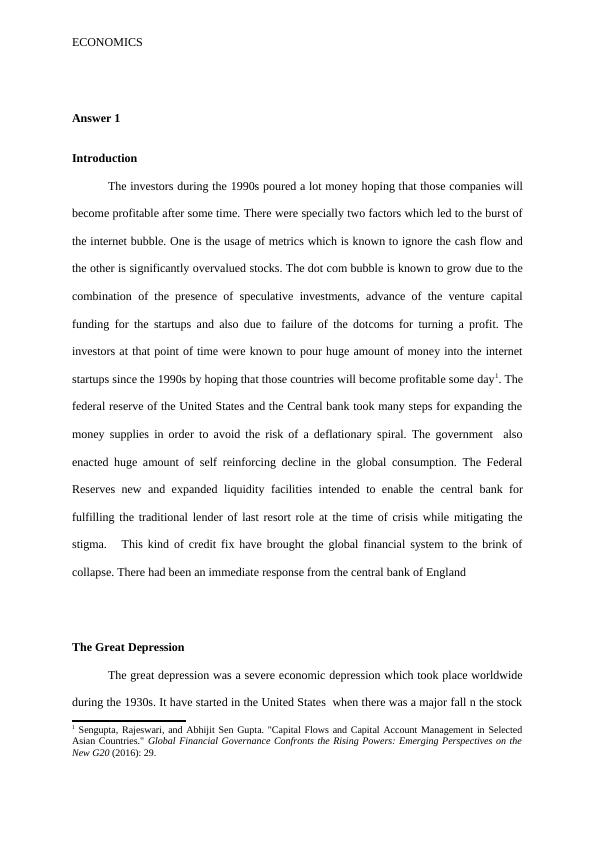
ECONOMICS
prices that took place in 1929 and the stock market crashed for the entire world. As a result
of this , the gross domestic product worldwide declined to 15 percent. The great depression
had a huge devastating effects for both the rich as well as for the poor. The sudden collapse
of the US stock market took place in 29th October 1929 which is also termed as Black
Tuesday. After that the rates of interest have declined a lot and people had to decrease their
spending. Prices in general started to decline leading to a deflationary spiral in 1931. The
main causes of the great depression is the crash of stock market in 1929, bank failures,
reduction in purchase across the board and severe drought condition. One of the main reason
of the Great Depression was the crash of the stock market which is known to take place in 29
the October , 1929. The stockholders at that point f time had lost more than $40billion of
investment and the effect of the crash of stock market rippled throughout the economy. More
than five hundred banks k own to have failed during 1929 and more than three thousand
banks of the collapsed at that time. This kind of situation also made people to spend less
amount of money2. When the huge amount of savings became worthless in nature their
investments started to diminish. Both consumers and companies used to spend less and
therefore, there was recession. For this reason, large number of workers were laid off. Since
most of the people were losing jobs, they were not able to pay for the goods which they had
already bought though instalment plans. Also, at that point of time, the rate of unemployment
rose by more than 20 percent which also meant that less spending to help alleviate the
economic situation. Since The Great Depression lead to severe loss in the economy, the
government off he United States was forced to act for protecting the US industry. The
government at that point of time imposed tariff on the imported goods and for that reason a
large number of trading partners retaliated by imposing tariffs on the goods made in US
which resulted in decline of the world trade between 1929 and 1934. The economic condition
2 Castells, Manuel. Another economy is possible: culture and economy in a time of crisis. John Wiley & Sons,
2017.
prices that took place in 1929 and the stock market crashed for the entire world. As a result
of this , the gross domestic product worldwide declined to 15 percent. The great depression
had a huge devastating effects for both the rich as well as for the poor. The sudden collapse
of the US stock market took place in 29th October 1929 which is also termed as Black
Tuesday. After that the rates of interest have declined a lot and people had to decrease their
spending. Prices in general started to decline leading to a deflationary spiral in 1931. The
main causes of the great depression is the crash of stock market in 1929, bank failures,
reduction in purchase across the board and severe drought condition. One of the main reason
of the Great Depression was the crash of the stock market which is known to take place in 29
the October , 1929. The stockholders at that point f time had lost more than $40billion of
investment and the effect of the crash of stock market rippled throughout the economy. More
than five hundred banks k own to have failed during 1929 and more than three thousand
banks of the collapsed at that time. This kind of situation also made people to spend less
amount of money2. When the huge amount of savings became worthless in nature their
investments started to diminish. Both consumers and companies used to spend less and
therefore, there was recession. For this reason, large number of workers were laid off. Since
most of the people were losing jobs, they were not able to pay for the goods which they had
already bought though instalment plans. Also, at that point of time, the rate of unemployment
rose by more than 20 percent which also meant that less spending to help alleviate the
economic situation. Since The Great Depression lead to severe loss in the economy, the
government off he United States was forced to act for protecting the US industry. The
government at that point of time imposed tariff on the imported goods and for that reason a
large number of trading partners retaliated by imposing tariffs on the goods made in US
which resulted in decline of the world trade between 1929 and 1934. The economic condition
2 Castells, Manuel. Another economy is possible: culture and economy in a time of crisis. John Wiley & Sons,
2017.

ECONOMICS
at the time of great depression had been made worse by the year long drought. The year long
drought with traditional arming practice which did not know how to preserve soil lead to
huge amount of dust storms which killed many people. Therefore, thousands of people had to
run when the economy collapsed.
The monetary policy of the Federal Reserve had been is guided between 1929 to 1933
since at that time, it only had two tools for influencing the money supply which are the open
market operations and the discount rate which the banks are allowed to borrow from Fred.
The Federal Reserve at that time paid close attention to the international gold standard. When
there was a crash in the stock market in the year 1929, the response of New York had been
quite rapid and effective in nature3. They at that time were known to inject liquidity by
conducting huge scale of open market operations. The supply of money at that time also fell
sharply and was same till the 1934. The Federal Reserve at that time reduced the amount of
credit outstanding which also forced the banks to sell their assets in order to get emergency
liquidity. After that when the gold standard was abandoned by Great Britain during 1931, the
central bank had to increase the discount rate in order to prevent outflows of capital. This
however had put huge pressure on the banks where more than 1800 failed. Until the month of
April in 1932, large scale open market operations were known to be delayed and for that
reason, by July of that year, the stock market had already crashed and had fallen by a loss of
89 percent.
3 Lins, Karl V., Henri Servaes, and Ane Tamayo. "Social capital, trust, and firm performance: The value of
corporate social responsibility during the financial crisis." The Journal of Finance 72.4 (2017): 1785-1824.
at the time of great depression had been made worse by the year long drought. The year long
drought with traditional arming practice which did not know how to preserve soil lead to
huge amount of dust storms which killed many people. Therefore, thousands of people had to
run when the economy collapsed.
The monetary policy of the Federal Reserve had been is guided between 1929 to 1933
since at that time, it only had two tools for influencing the money supply which are the open
market operations and the discount rate which the banks are allowed to borrow from Fred.
The Federal Reserve at that time paid close attention to the international gold standard. When
there was a crash in the stock market in the year 1929, the response of New York had been
quite rapid and effective in nature3. They at that time were known to inject liquidity by
conducting huge scale of open market operations. The supply of money at that time also fell
sharply and was same till the 1934. The Federal Reserve at that time reduced the amount of
credit outstanding which also forced the banks to sell their assets in order to get emergency
liquidity. After that when the gold standard was abandoned by Great Britain during 1931, the
central bank had to increase the discount rate in order to prevent outflows of capital. This
however had put huge pressure on the banks where more than 1800 failed. Until the month of
April in 1932, large scale open market operations were known to be delayed and for that
reason, by July of that year, the stock market had already crashed and had fallen by a loss of
89 percent.
3 Lins, Karl V., Henri Servaes, and Ane Tamayo. "Social capital, trust, and firm performance: The value of
corporate social responsibility during the financial crisis." The Journal of Finance 72.4 (2017): 1785-1824.
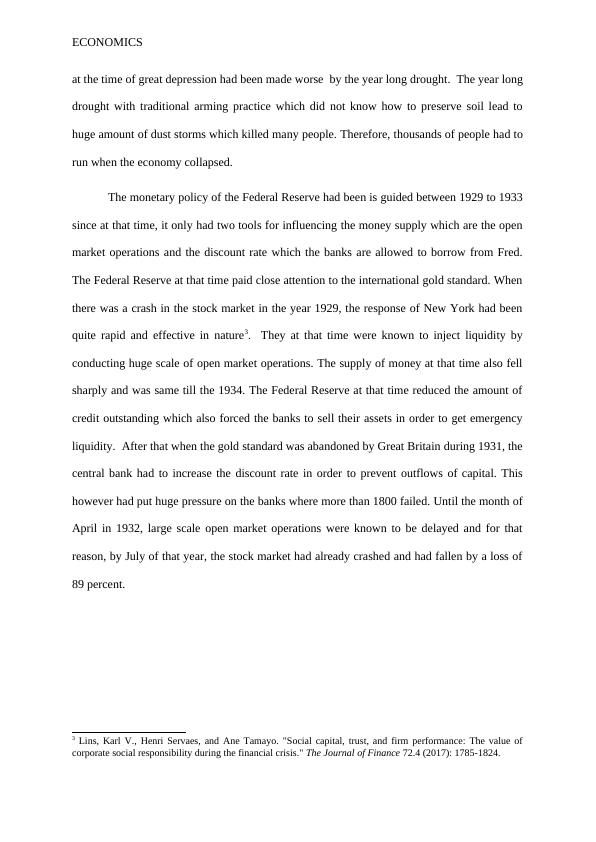
ECONOMICS
Response of policymakers during Great Depression
In the United States, the Federal Reserve Bank are known to control the monetary
policy whereas the President controls the fiscal policy. During the year 1932, Franklin D.
Roosevelt, the President of USA created various federal government programs. The president
signed new deals which were designed for creation of more jobs, allowing unionization and
also provided them with unemployment insurance. The new deal made by the president
helped in safeguarding the economy and also prevented another depression. The huge number
of bank failures forced the government to establish the National Credit Cooperation in the
year 1932 which was designed for helping the commercial banks for purchasing marketable
assets and also provide alternative borrowing facilities. The government in 1932 campaigned
in favour of conservative fiscal policy for fighting the Great Depression. The policymakers
however did not do much before 1932. The government advocated for sharp reduction of the
government expenditures and abolished useless commissions. The monetary policy was not
used for stimulating the economy at that period of time. Electing President Franklin
Roosevelt at that point of time became the turning point. He created a series of measures for
fighting great depression which was termed as the “New Deal” which was used for stabilizing
the economy. The government of the United States in terms of fiscal policy, moved away
from the balanced budget by adopting an aggressive spending policy. After that the spending
of government rose from 3.2 percent of gross domestic product to 9.3 percent of gross
domestic product from 1932 to 1936. These spending’s ere then financed by the budget
deficits. The government also created a system of deposit insurance for stabilizing the
banking system. The New Deal made by the government not only brought changes in policy
but also brought changes in attitudes towards the policymaking.
Response of policymakers during Great Depression
In the United States, the Federal Reserve Bank are known to control the monetary
policy whereas the President controls the fiscal policy. During the year 1932, Franklin D.
Roosevelt, the President of USA created various federal government programs. The president
signed new deals which were designed for creation of more jobs, allowing unionization and
also provided them with unemployment insurance. The new deal made by the president
helped in safeguarding the economy and also prevented another depression. The huge number
of bank failures forced the government to establish the National Credit Cooperation in the
year 1932 which was designed for helping the commercial banks for purchasing marketable
assets and also provide alternative borrowing facilities. The government in 1932 campaigned
in favour of conservative fiscal policy for fighting the Great Depression. The policymakers
however did not do much before 1932. The government advocated for sharp reduction of the
government expenditures and abolished useless commissions. The monetary policy was not
used for stimulating the economy at that period of time. Electing President Franklin
Roosevelt at that point of time became the turning point. He created a series of measures for
fighting great depression which was termed as the “New Deal” which was used for stabilizing
the economy. The government of the United States in terms of fiscal policy, moved away
from the balanced budget by adopting an aggressive spending policy. After that the spending
of government rose from 3.2 percent of gross domestic product to 9.3 percent of gross
domestic product from 1932 to 1936. These spending’s ere then financed by the budget
deficits. The government also created a system of deposit insurance for stabilizing the
banking system. The New Deal made by the government not only brought changes in policy
but also brought changes in attitudes towards the policymaking.
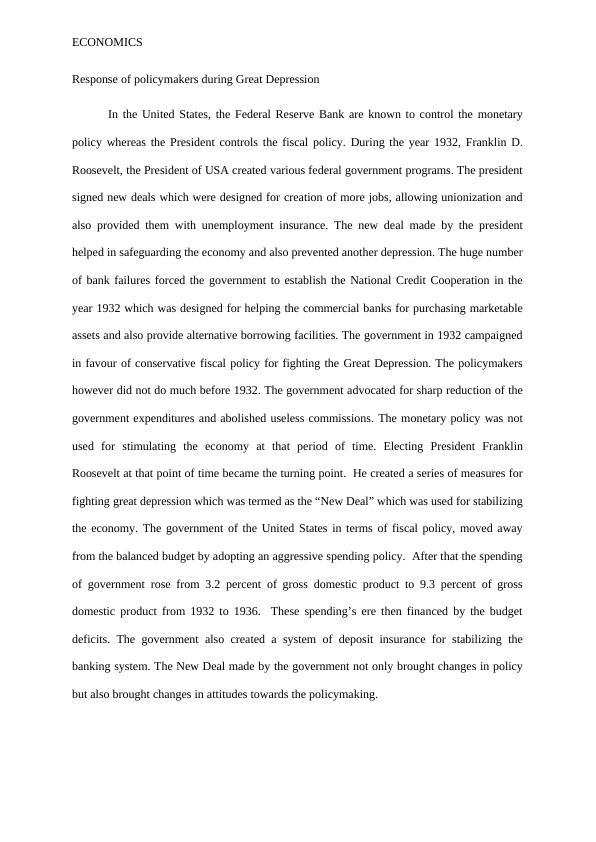
ECONOMICS
Asian financial crisis
The Asian Financial crisis originated in Thailand n the year 1997 and then quickly
spread to other parts of East Asia. The financial crisis of Asia was known to be have gripped
much of East as well as Southeast Asia which began in 1997 and increased fears of a
worldwide economic meltdown as a result of financial contagion. The financial crisis have
started in Thailand where the Thai Baht have collapsed and then the government of Thailand
were forced to float the baht. The government was forced to do so due to lack of foreign
currency in order to support its currency peg. The Asian Contagion was the sequence of
currency devaluations that began in 1979. Since the government of Thailand decided not to
peg the local currency o the US dollar, the currency market of Thailand failed for the first
time and then it spread rapidly throughout Asia. As a result of this, the stock market crashed
which also reduced revenues. Due to the devaluation of Baht, the East Asian currencies fell
sharply by 38 percent. The countries which were mostly affected by the Asian financial crisis
were South Korea, Indonesia and Thailand compared to Singapore, Taiwan, Vietnam and
china which were comparatively less affected due to the financial crises. The foreign debt to
gross domestic ratios increased from 100 percent to 167 percent in case of ASEA economies.
One of the reason of the Asian currency crisis was due to macroeconomic weakness. Though
both the fiscal and monetary policies aimed at stabilizing the monetary impact of the large
capital inflows, they however avoided large appreciations against the US dollar which was
the main currency against which they pegged their exchange rates. Many countries include
Thailand and Korea suffered from showdowns of substantial exports in the year 1996 despite
the high rate of investment. The macroeconomic situation at the end of 1996, presented a
troubling situation for some of the countries. During the 1990s, the Asian countries
experienced huge amount of capital inflows which ranged from 3 percent of GDP in case of
Korea to 10 percent in Malaysia. Large amount of inflows of capital, were known to be
Asian financial crisis
The Asian Financial crisis originated in Thailand n the year 1997 and then quickly
spread to other parts of East Asia. The financial crisis of Asia was known to be have gripped
much of East as well as Southeast Asia which began in 1997 and increased fears of a
worldwide economic meltdown as a result of financial contagion. The financial crisis have
started in Thailand where the Thai Baht have collapsed and then the government of Thailand
were forced to float the baht. The government was forced to do so due to lack of foreign
currency in order to support its currency peg. The Asian Contagion was the sequence of
currency devaluations that began in 1979. Since the government of Thailand decided not to
peg the local currency o the US dollar, the currency market of Thailand failed for the first
time and then it spread rapidly throughout Asia. As a result of this, the stock market crashed
which also reduced revenues. Due to the devaluation of Baht, the East Asian currencies fell
sharply by 38 percent. The countries which were mostly affected by the Asian financial crisis
were South Korea, Indonesia and Thailand compared to Singapore, Taiwan, Vietnam and
china which were comparatively less affected due to the financial crises. The foreign debt to
gross domestic ratios increased from 100 percent to 167 percent in case of ASEA economies.
One of the reason of the Asian currency crisis was due to macroeconomic weakness. Though
both the fiscal and monetary policies aimed at stabilizing the monetary impact of the large
capital inflows, they however avoided large appreciations against the US dollar which was
the main currency against which they pegged their exchange rates. Many countries include
Thailand and Korea suffered from showdowns of substantial exports in the year 1996 despite
the high rate of investment. The macroeconomic situation at the end of 1996, presented a
troubling situation for some of the countries. During the 1990s, the Asian countries
experienced huge amount of capital inflows which ranged from 3 percent of GDP in case of
Korea to 10 percent in Malaysia. Large amount of inflows of capital, were known to be

ECONOMICS
intermediated through weak domestic financial institutions. The combination of large amount
of capital inflows with financial sectors and the involvement of government lead to financial
fragility of an overleveraged corporate sector. During the 1990s, these Asian countries like
Indonesia and Thailand were known to have large amount of deficits in current account while
maintaining the fixed exchange rates encouraged for external borrowing leading to foreign
exchange risk. Devaluation of Chinese currency and the Japanese Yen with the increasing
interest rate of the United States adversely affected the growth of the Asian countries. The
higher US Dollar made the exports of Asian countries more expensive and less completive in
the global markets which slowed the growth of exports of the south Asian countries leading
to the deterioration of the position of the current account.
Response of the policymakers
The situation got better with the intervention of the International Monetary Fund that
provided enough loans for stabilizing the Asian economies. The International Monetary Fund
have provided $110 billion loans Thailand, South Korea and Indonesia for helping them to
stabilize their economies. The financial crisis which took place in Thailand with a lot of
speculative attacks on the baht known to unfold after several decades. The IMF was called in
in order to provide financial support for the above mentioned countries that have been
seriously affected. The strategy includes macroeconomic policies, structural reforms and
financing. An amount of US$35 billion of IMF financial support had been provided to the
Asian economies for adjustments programmes. The monetary policy had been tightened in
order to save the country from the collapse of the exchange rates. The tightening of the
monetary policy were although had been temporary in nature. The tight monetary policy
prevented currency depreciation which can lead to inflation and continuing depreciation of
the currencies. There was only little or no attempt made for raising the interest rates. The
government of Thailand also aimed for contractionary fiscal policy which was introduced for
intermediated through weak domestic financial institutions. The combination of large amount
of capital inflows with financial sectors and the involvement of government lead to financial
fragility of an overleveraged corporate sector. During the 1990s, these Asian countries like
Indonesia and Thailand were known to have large amount of deficits in current account while
maintaining the fixed exchange rates encouraged for external borrowing leading to foreign
exchange risk. Devaluation of Chinese currency and the Japanese Yen with the increasing
interest rate of the United States adversely affected the growth of the Asian countries. The
higher US Dollar made the exports of Asian countries more expensive and less completive in
the global markets which slowed the growth of exports of the south Asian countries leading
to the deterioration of the position of the current account.
Response of the policymakers
The situation got better with the intervention of the International Monetary Fund that
provided enough loans for stabilizing the Asian economies. The International Monetary Fund
have provided $110 billion loans Thailand, South Korea and Indonesia for helping them to
stabilize their economies. The financial crisis which took place in Thailand with a lot of
speculative attacks on the baht known to unfold after several decades. The IMF was called in
in order to provide financial support for the above mentioned countries that have been
seriously affected. The strategy includes macroeconomic policies, structural reforms and
financing. An amount of US$35 billion of IMF financial support had been provided to the
Asian economies for adjustments programmes. The monetary policy had been tightened in
order to save the country from the collapse of the exchange rates. The tightening of the
monetary policy were although had been temporary in nature. The tight monetary policy
prevented currency depreciation which can lead to inflation and continuing depreciation of
the currencies. There was only little or no attempt made for raising the interest rates. The
government of Thailand also aimed for contractionary fiscal policy which was introduced for
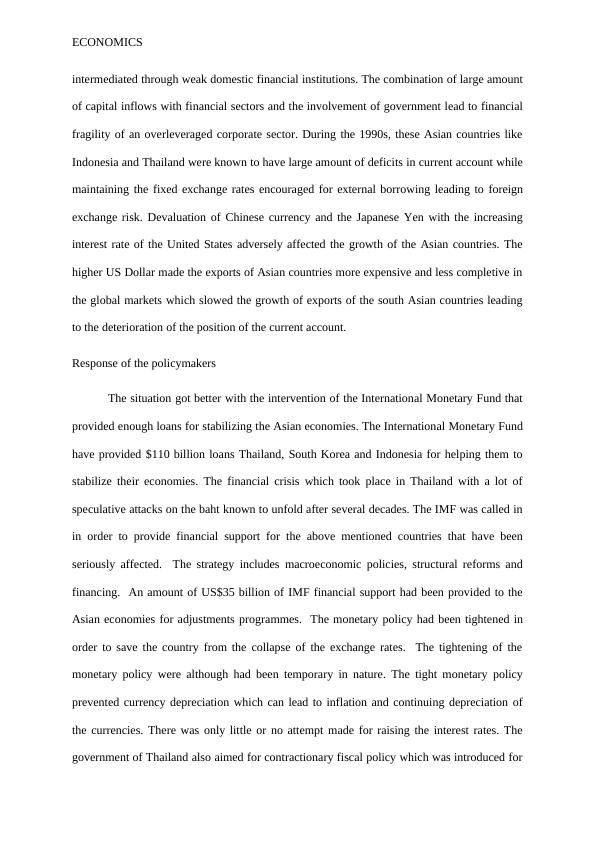
ECONOMICS
reducing the excessive deficit of current account. The programs which were supported by
IMF had been less successful for restoring the confidence of South Korea, Indonesia and
Thailand. The financial markets then stabilized during 1998 at first in Korea and Thailand.
The exchange rates started to recover and then rate of interest also started to decline after
that. The contractionary monetary policy imposed by the government helped in reversing the
pressure of the exchange rate and also prevent the inflationary spirals. Therefore, it can be
said that structural reforms were important for restoring the confidence of the firm.
The international monetary fund recommended a sharp rise in the rate of interest for
restoring confidence, stabilizing the currency and outflow of stem capital for the crisis
affected countries. However, many economist stated that this particular approach made by
IMF was counterproductive. They stated that the low interest rate could have made it quite
easier for the firms for maintain production by restoring the confidence of the investors.
The dot com bubble
The dot com bubble took place in 1994 in the United States. During the dot com
bubble, the value of the equity markets grew tremendously where Nasdaq index increased
from 1000 to 5000 between 1995 to 2000. After that stock market crashed and lasted till
2002. When the stock market crashed, a lot of online shopping companies and
communication companies like WorldCom and Global Crossing have failed and had shut
down. The investors during the 1990s poured a lot money hoping that those companies will
become profitable after some time. There were specially two factors which led to the burst of
the internet bubble. One is the usage of metrics which is known to ignore the cash flow and
the other is significantly overvalued stocks. The dot com bubble is known to grow due to the
combination of the presence of speculative investments, advance of the venture capital
reducing the excessive deficit of current account. The programs which were supported by
IMF had been less successful for restoring the confidence of South Korea, Indonesia and
Thailand. The financial markets then stabilized during 1998 at first in Korea and Thailand.
The exchange rates started to recover and then rate of interest also started to decline after
that. The contractionary monetary policy imposed by the government helped in reversing the
pressure of the exchange rate and also prevent the inflationary spirals. Therefore, it can be
said that structural reforms were important for restoring the confidence of the firm.
The international monetary fund recommended a sharp rise in the rate of interest for
restoring confidence, stabilizing the currency and outflow of stem capital for the crisis
affected countries. However, many economist stated that this particular approach made by
IMF was counterproductive. They stated that the low interest rate could have made it quite
easier for the firms for maintain production by restoring the confidence of the investors.
The dot com bubble
The dot com bubble took place in 1994 in the United States. During the dot com
bubble, the value of the equity markets grew tremendously where Nasdaq index increased
from 1000 to 5000 between 1995 to 2000. After that stock market crashed and lasted till
2002. When the stock market crashed, a lot of online shopping companies and
communication companies like WorldCom and Global Crossing have failed and had shut
down. The investors during the 1990s poured a lot money hoping that those companies will
become profitable after some time. There were specially two factors which led to the burst of
the internet bubble. One is the usage of metrics which is known to ignore the cash flow and
the other is significantly overvalued stocks. The dot com bubble is known to grow due to the
combination of the presence of speculative investments, advance of the venture capital
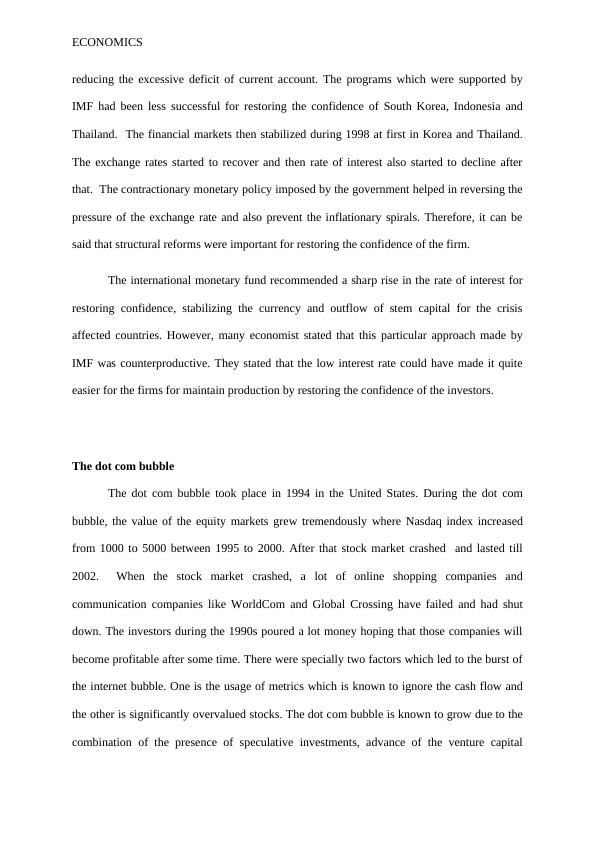
End of preview
Want to access all the pages? Upload your documents or become a member.
Related Documents
The Great Depressionlg...
|7
|1626
|95
Report on Analysis of Great Depressionlg...
|8
|1566
|313
MBA 6641- International Economics Assignmentlg...
|6
|725
|290
Global Financial Crisis: Causes, Impacts and Reformslg...
|12
|3107
|295
The Stock Market Crash of 1929: Causes, Effects, and Aftermathlg...
|8
|1855
|167
Global Financial Crisis and Dotcom Bubblelg...
|6
|961
|300
